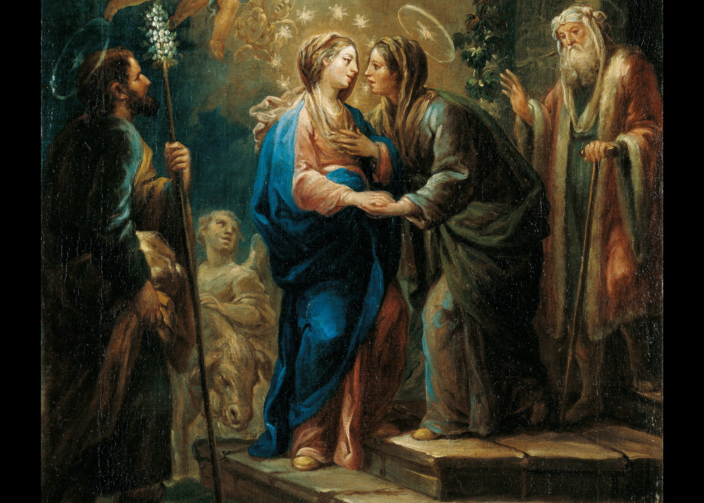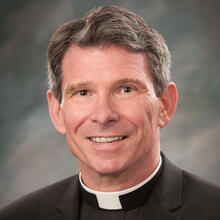A Homily for the Feast of the Assumption
Vigil: 1 Chronicles 15:3-4, 15-16; 16: 1-2 1 Corinthians 15:54b-57 Luke 11:27-28
Mass during the day: Revelation 11:19A; 12:1-6A, 10AB 1 Corinthians 15:20-27 Luke 1:39-56
In his encyclical “Laudato Si’: On Care for Our Common Home,” Pope Francis shares a new insight into the mystery that is Mary: She is where creation receives and welcomes its savior.
Reflecting upon a Trinity turned toward its creation, Francis writes:
The Father is the ultimate source of everything, the loving and self-communicating foundation of all that exists. The Son, his reflection, through whom all things were created, united himself to this earth when he was formed in the womb of Mary. The Spirit, infinite bond of love, is intimately present at the very heart of the universe, inspiring and bringing new pathways (No. 238).
The Western, monotheistic religions of revelation—Judaism, Christianity and Islam—are united in their insistence upon the transcendence of God. The world is not divine. Whatever the divine might be when fully revealed, it stands beneath and beyond the world. This world is incomplete; it yearns for something beyond itself. In these three faiths, God is understood to be the fulfillment this world seeks.
Francis captures the core of the Christian message and advances our understanding of Mary when he writes that Christ “united himself to this earth when he was formed in the womb of Mary.” In her, God, who is pure spirit, pure intelligence, enters his own creation, becoming one with it.
More than “ark” or “tabernacle,” perhaps “womb” captures the dynamism of God’s union with creation. God enters earth, makes it fertile, causes it to bring forth something quite beyond itself. In the womb of Mary, God loves creation into something new.
In speaking of our relationship to the earth, Pope John Paul II typically employed traditional Christian terms such as “master,” “subdue,” “exploit” (usus), and “dominate.” Pope Benedict XVI chose a better term, “cultivate.” But as Lucas Briola notes in The Eucharistic Vision of Laudato Si: Praise, Conversion, and Integral Theology (2023), the term “care,” which Francis employs 40 times in his encyclical, suggests a response born of love, even passion.
We care for creation because God loves it. God entered creation with great passion, when Christ “united himself to this earth when he was formed in the womb of Mary.” A new creation is born of God’s care, God’s passionate love for it.
In Mary’s womb, God reveals himself as creation’s author and lover. In Mary’s womb, creation becomes care. Care reveals who God is towards creation and who we must be toward it as well: those who care for it.
The dogma of the Assumption was, quite frankly, born of the church’s own, spirit-filled intuition. Intuition is how all knowledge advances. It must leap. It never simply flows from one datum to the next.
Of course we can intuit wrongly. All human activity is subject to error, but what we cannot do is stop intuiting. It is the only way forward. Ultimately, intuition reveals its integrity by the depth of the insight it provides. True intuitions lead to ever greater insights.
The Blessed Virgin Mary did not experience death as we will, under the reign of sin and exploitation. She did not depart this earth as we will, adapting lines from Gerard Manley Hopkins poem “God’s Grandeur.”
And all is seared with trade; bleared, smeared with toil;
And wears man’s smudge and shares man’s smell.
No, the Virgin is that spot in creation, where the creator begins again, where the “mortal clothes itself with immortality” (1 Cor 15:54). God does not exploit her or allow her to be exploited. God cares for her and in that care dawns our very salvation.
At the end of the ages, when we look upon the Virgin, we will see the lasting imprint of God’s care for her. We will both “hear the word of God and observe it” (Lk 11:28). By virtue of the Spirit’s touch, his presence within her, she stands with Christ as a pristine point in creation. In her womb, the creator enters and pivots creation back into life, back into God.
For just as in Adam all die,
so too in Christ shall all be brought to life, but each one in proper order:
Christ the firstfruits;
then, at his coming, those who belong to Christ (1 Cor 15:22-23).
Pope Francis closes his encyclical with what he calls “A Christian Prayer in Union with Creation.” Here is its verse on the Virgin.
Son of God, Jesus,
through you all things were made.
You were formed in the womb of Mary our Mother,
you became part of this earth,
and you gazed upon this world with human eyes.
Today you are alive in every creature in your risen glory.
Praise be to you!








